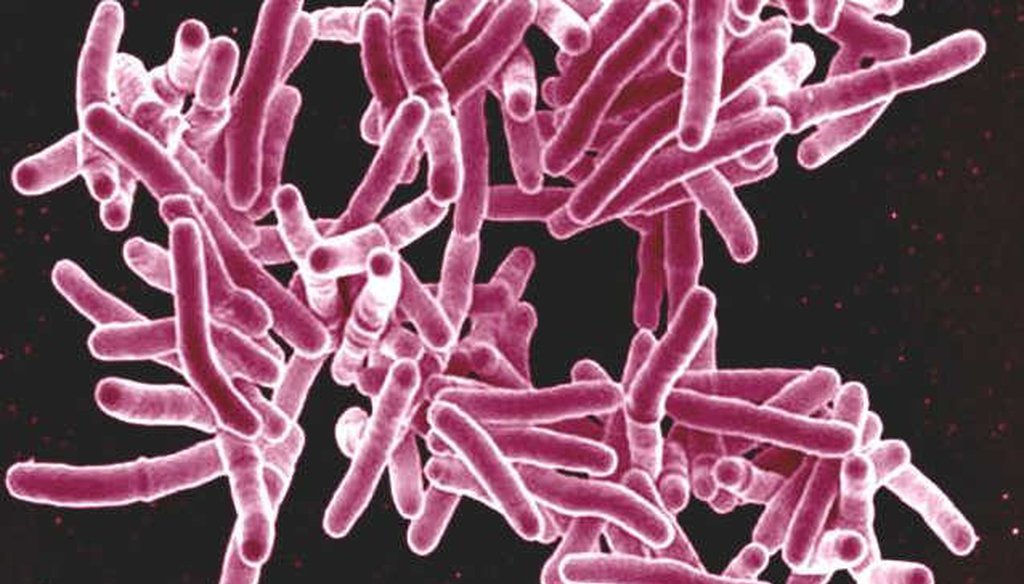Get PolitiFact in your inbox.

A scanning electron micrograph of the mycobacterium tuberculosis bacteria, which causes TB. (NIAID)
Disease. Tuberculosis is one of the top infectious killers worldwide, with about 11-14 million people living with active infections. The disease usually attacks the lungs, but it can also take hold in the brain, kidneys or spine.
Impact. In 2014 1.5 million people died from TB. The total TB death rate is dropping -- between 1990 and 2015 it dropped by 47 percent. However, TB is a leading killer of people who are HIV infected.
Source: WHO
Symptoms. Bad cough that lasts 3 weeks or longer (with or without coughing up blood), pain in chest, weakness, weight loss, fever, and night sweats.
How it spreads? TB bacteria spreads from one person to another through the air. The TB bacteria are released when a person coughs, sneezes, speaks, or even sings. When people nearby breathe in these bacteria for several hours they may become infected.
Where in the world? - TB occurs in every part of the world but over 95 percent of TB deaths occur in low- and middle-income countries. In 2014, the largest number of new TB cases occurred in the South-East Asia and Western Pacific Regions. However, Africa carried the most severe burden with 281 cases per 100,000 population in 2014.
In 2014, about 80 percent of reported TB cases occurred in 22 countries. The 6 countries that stand out as having the largest number of incident cases are India, Indonesia, Nigeria, Pakistan, People’s Republic of China and South Africa.Treatment and prevention. In most cases, TB can be treated and cured by taking one or more antibiotic drugs for 6 to 12 months. It is very important that people who begin treatment finish the medicine, and take the drugs exactly as prescribed. Otherwise they can become sick again. This has helped fuel the emergence of multidrug-resistant and extensively drug-resistant TB. Controlling these varieties requires more intensive and in some cases, new medications.There is a vaccine that is used in some countries to prevent severe forms of TB in children. However, it is not generally recommended in the United States because it has limited effectiveness for preventing TB overall.
In the United States. There has been a steady decline in the number of persons with TB since 1993. A total of 9,421 TB cases were reported in the United States in 2014. There were 555 deaths from TB in 2013, the most recent year for which these data are available.
* Source: Centers for Disease and Prevention
Traveling. All travelers should avoid high risk settings where there are no infection control measures in place. Transmissions might occur in crowded hospitals, prisons, homeless shelters etc. Air travel itself carries a relatively low risk of infection with TB.
Elimination. TB was declared a global health emergency in 1993, and since then, global efforts to address TB have become more prominent, and global TB incidence, prevalence, and mortality rates have fallen. Some countries like Brazil and China are experiencing a major decline in cases, while in others the numbers are dropping very slowly.
Costs. Approximately US$ 6.6 billion was available for TB prevention, diagnosis and treatment in 2015 which is estimated to be too little for a full response to the global epidemic.
U.S. government funding. Funding for TB has decreased from as high as $256 million in FY 2012 to approximately $240 million yearly since then. The request for the FY 2017 is 19% lower.
Our Sources
World Health Organization, Tuberculosis, accessed on May 17, 2016
World Health Organization, Global Tuberculosis report 2015
Centers for Disease Control and Prevention, Tuberculosis, accessed on May 19, 2016
Kaiser Family Foundation The U.S. Government and Global Tuberculosis Efforts, March 23, 2016
Photo credit: NIAID, published under Flickr.com Creative Commons license, November 5, 2010
























